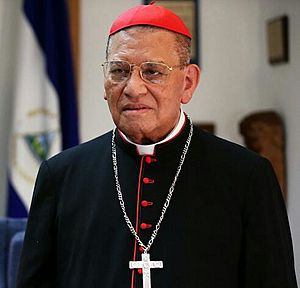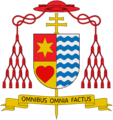Miguel Obando y Bravo facts for kids
Quick facts for kids His Eminence Miguel Obando y Bravo SDB |
|
|---|---|
| Cardinal, Archbishop of Managua | |
 |
|
| Church | Roman Catholic Church |
| Archdiocese | Managua |
| See | Managua |
| Appointed | 16 February 1970 |
| Enthroned | 4 April 1970 |
| Reign ended | 1 April 2005 |
| Predecessor | Vicente Alejandro González y Robleto |
| Successor | Leopoldo José Brenes Solórzano |
| Other posts | Cardinal-Priest of San Giovanni Evangelista a Spinaceto |
| Orders | |
| Ordination | 10 August 1958 |
| Consecration | 31 March 1968 by Marco Antonio García y Suárez |
| Created Cardinal | 25 May 1985 |
| Rank | Cardinal-Priest |
| Personal details | |
| Birth name | Miguel Obando y Bravo |
| Born | 2 February 1926 La Libertad, Nicaragua |
| Died | 3 June 2018 (aged 92) Managua, Nicaragua |
| Nationality | Nicaraguan |
| Denomination | Roman Catholic |
| Previous post |
|
| Motto | Omnibus omnia factus |
| Coat of arms |  |
Miguel Obando y Bravo (February 2, 1926 – June 3, 2018) was an important Nicaraguan leader in the Catholic Church. He served as the Archbishop of Managua for many years, from 1970 to 2005. In 1985, Pope John Paul II made him a cardinal, which is a very high rank in the Church. He was the first cardinal from Nicaragua.
Contents
Early Life and Church Career
Miguel Obando y Bravo was born in La Libertad, a town in the Chontales area of Nicaragua. He joined the Salesian order, a group of priests and brothers.
Becoming a Bishop
In 1968, he became a Titular Bishop, which means he was given the title of a bishop for a place that no longer has a bishop. He also became an Auxiliary Bishop for the city of Matagalpa. His special motto as a bishop was Omnibus omnia factus, which means "I have become all things to all people."
Archbishop of Managua
Just two years later, in 1970, Pope Paul VI chose him to be the Archbishop of Managua. This made him the main leader of the Catholic Church in Nicaragua's capital city. He also led the group of bishops in Nicaragua, called the Episcopal Conference, several times.
Becoming a Cardinal
In 1985, Pope John Paul II made him a Cardinal-Priest. This was a very special moment for Nicaragua. As a cardinal, he was able to vote for a new Pope. He took part in the 2005 papal conclave, which is when cardinals meet to choose the next Pope. In that meeting, Pope Benedict XVI was chosen.
Later Years and Retirement
Cardinal Obando y Bravo retired as Archbishop of Managua in 2005. Even after retiring, he continued to work for peace in Nicaragua. He was asked by the Nicaraguan president to lead a group focused on peace and making things better after a civil war. He said that Pope Benedict XVI encouraged him to help bring people together in Nicaragua. He passed away in Managua in 2018 at the age of 92.
Honors and Awards
Cardinal Obando y Bravo received many awards for his work for peace and freedom.
- In 1979, he received the Bruno Kreisky Award for peace and freedom from Austria.
- He also received a special plaque for peace and freedom from the Nicaraguan people in the United States.
- In 1981, he was given the Venezuelan Order of Francisco Miranda.
- In 1986, a university in Guatemala gave him an honorary degree, which is a special award for his achievements.
Important Views and Actions
Cardinal Obando y Bravo was a strong voice in Nicaragua during a time of big changes.
Speaking Out Against the Government
In the late 1970s, he spoke out against the government of Anastasio Somoza Debayle. He wrote letters and articles criticizing the government for being unfair and for not helping people after the big earthquake in 1972. He also spoke against the government's military for hurting people. He showed his disapproval by not accepting gifts from the government.
Working with the Sandinistas
He sometimes acted as a go-between, or mediator, between the Sandinista group and the Somoza government. He even supported the Sandinistas' fight to remove the Somoza government. Some people even called him "Comandante Miguel" because he seemed like a leader of the Sandinistas.
Challenges with the Sandinista Government
However, his relationship with the Sandinistas changed when they came to power. He disagreed with some of their ideas, especially those that seemed to go against the Church's teachings. He believed that priests should not be involved in government politics. He also criticized the Sandinistas for limiting freedom of the press and for human rights issues.
He traveled to the United States and spoke in favor of a group called the Contras, who were fighting against the Sandinista government. This caused a big disagreement between him and the government. Even though the Sandinistas were popular, many Nicaraguans respected Cardinal Obando y Bravo, and his actions had a big impact.
See also
 In Spanish: Miguel Obando y Bravo para niños
In Spanish: Miguel Obando y Bravo para niños
- The Catholic Church and the Nicaraguan Revolution
Images for kids


